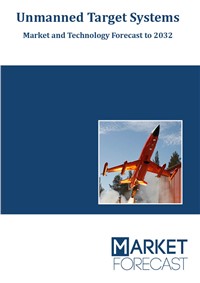Unmanned Target Systems market consists of ground, aerial and naval based platforms that can be operated autonomously as well as remotely. The platforms are equipped with various payloads and avionics that enable the system to replicate real-world ground, air, and naval based threats. They are used to imitate aircraft, missiles, UAVs, speed boats, submarines, attack convoy of ground-based vehicles, among others, to train, test and validate various weapon systems.
The market players include large as well as mid to small sized companies with expertise in manufacturing and unmanned technology.
Unmanned target systems market is a niche but growing market. Rising defence spending on defence weapon systems and increased need for mission readiness of those systems has directly led to the demand of unmanned training systems as they are used to train, test, and validate the weapon systems. Hence, driving the demand for unmanned target systems.
Additionally, Artificial Intelligence (AI), Machine Learning (ML), cloud computing, additive manufacturing, Internet of Things (IoT), and many other such Industry 4.0 technologies will drive the spending in the market as they make the platforms and systems more efficient and provide additional cost savings in the long run.
The study “Unmanned Target Systems - Market and Technology Forecast to 2032” examines, analyses, and predicts the evolution of unmanned target systems technologies, markets, and outlays (expenditures) over the next 8 years – 2025-2032 in the aerospace industry. It also examines markets geographically, focusing on the top 95% of global markets, in the North America, Europe, Asia Pacific, Middle East & Africa, and Latin America.
Throughout the report we show how unmanned target systems are used today to add real value, as well as how will they can evolve in the near and distant future. To provide the most thorough and realistic forecast, this report provides a twin-scenario analysis.
Covered in this study
- Overview: Snapshot of the unmanned target systems market during 2024-2032, including highlights of the demand drivers, trends, and challenges. It also provides a snapshot of the spending with respect to regions as well as segments and sheds light on the emergence of new technologies.
- Market Dynamics: Insights into the technological developments in the market and a detailed analysis of the changing preferences of governments around the world. It also analyses changing industry structure trends and the challenges faced by the industry participants.
- Segment Analysis: Insights into the various operation mode and platform type markets from a segmental perspective and a detailed analysis of factors influencing the market for each segment.
- Regional Review: Insights into defence spending, procurement patterns and development of the technology for top countries within a region.
- Regional Analysis: Insights into the segmental market from a regional perspective and a detailed analysis of factors influencing the market for each region.
- Impact Analysis: Analysis on how certain events will impact the unmanned target systems market. This will give you an indication on which factors are important for the forecast.
- Key Program Analysis: Details of the top programs in each segment expected to be executed during the forecast period.
- Competitive landscape Analysis: Analysis of competitive landscape of this industry. It provides an overview of key companies, together with insights such as key alliances, strategic initiatives, and a brief financial analysis.
Segmentation
We have segmented the Unmanned Target Systems by Region, Operation Mode, and Platform Type:Region
- North America
- Europe
- Asia Pacific
- Middle East & Africa
- Latin America
Operation Mode
- Autonomous
- Remote
Platform Type
- Ground
- Aerial
- Naval Surface
- Naval Underwater
Reasons to buy
- Determine prospective investment areas based on a detailed trend analysis of the global unmanned target systems industry over the next eight years.
- Gain in-depth understanding about the underlying factors driving demand for different application segments in the top spending countries across the world and identify the opportunities offered by each of them.
- Strengthen your understanding of the market in terms of demand drivers, industry trends, and the latest technological developments, among others.
- Identify the major channels that are driving the global unmanned target systems business, providing a clear picture about future opportunities that can be tapped, resulting in revenue expansion.
- Channelise resources by focusing on the ongoing programmes that are being undertaken by the ministries of different countries within the market.
- Make business decisions based on thorough analysis of the total competitive landscape of the sector with detailed profiles of the top platform providers around the world which include information about their products, alliances, recent contract wins and financial analysis wherever available.



